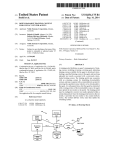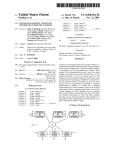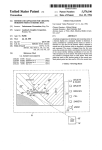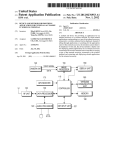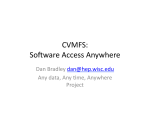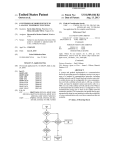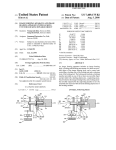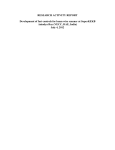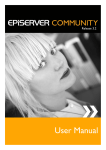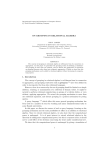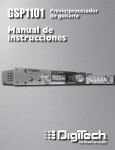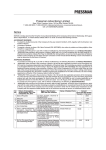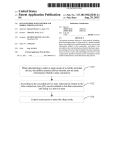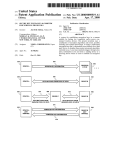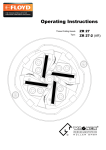Download Providing compliance enforcement for manually dialed wireless
Transcript
USOO8738076B1 (12) United States Patent (10) Patent N0.: Hitchcock et a]. (54) (45) Date of Patent: PROVIDING COMPLIANCE ENFORCEMENT (56) _ U~S~ PATENT DOCUMENTS _ 5,850,433 A (71) Apphcant: Noble Systems Corporation, Atlanta, (72) 8,606,245 B1 Inventors- Chad HltChCOCks JOhnS creek: GA Notice: 12/1998 Rondeau ................ .. 379/21801 3/2010 Kim 12/2013 Eccelston et al. 2005/0048967 A1* 3/2005 Hoglander et a1. ...... .. 455/426.l 2007/0015553 A1 1/2007 Siddiqui 2009/0003316 A1* 1/2009 Lee et al‘ ““““““““““ n 370/352 (Us); Ellwood Nell“, IILNeWHan, GA 2011/0165858 A1* 7/2011 Gisby etal. (US) 2012/0088475 A1* 4/2012 Portman et a1. 2013/0065558 A1* 2013/0143539 A1* 3/2013 6/2013 (73) Asslgnee: Noble Systems Corporation (*) * 7,783,290 B2 GA (US) . May 27, 2014 References Cited FOR MANUALLY DIALED WIRELESS NUMBERS IN A CONTACT CENTER _ US 8,738,076 B1 455/411 455/4121 O’Neil et a1. .... .. 455/411 Baccay et a1. .............. .. 455/416 OTHER PUBLICATIONS Subject to any disclaimer, the term Ofthis patent is eXtended or adjusted under 35 U_S_C_ 154(b) by 0 days Noble Systems Corporation, Maestro 2010.1.1 User Manual, v01. 1, Aug. 17, 2010,454 pages, Noble Systems Corporation, Atlanta, GA. Noble Systems Corporation, Maestro 2010.1.1 User Manual, v01. 2, Aug. 3, 2010, 416 pages, Noble Systems Corporation, Atlanta GA (21) App1.No.: 13/902,130 3039' (22) Primary Examiner * Dai A Phuong (Continued) Filed: May 24’ 2013 (57) Related US, Application Data (60) (51) (52) PrOViSiOnal application NO' 61/813’713’ ?led on Apr' compliance requirements. In one embodiment, a compliance 19’ 2013' server and a PBX cooperate to originate the call to the Wire Illt- C1H04M 1/00 US, Cl, less number. The agent logs into the compliance server and the compliance server provides the agent With a Wireless number to dial. The agent manually enters the Wireless num ber using a phone connected to the PBX. The PBX queries the USPC (58) ABSTRACT Systems and methods are disclosed for originating a call to a Wireless number by a contact center While enforcing various (2006-01) 455/555; 455/426,2; 455/462; 455/554_1; compliance server regarding establishing the Wireless call. 455/554,2; 455/556_1 Upon authorization, the PBX establishes a ?rst call leg to the compliance server, and a second call leg to the called party that iS joined With the call leg t0 the agent’s phone. Upon completion of the call, the agent dispositions the call to the compliance server, Which then releases the ?rst call leg. In Field of Classi?cation Search CPC ~ H04W 84/14; H04W 84/16; H04M 3/42314; H04M 3/42323; H04M 3/4234 USPC 455/412 1 426 2 428 460 519 527 iiiiiiiii n i ’ i ’ ’ 45 5 f5 5 4115 57’ See application ?le for complete search history. 1101: 1103 response, the PBX then releases the second call leg. 26 Claims, 11 Drawing Sheets ‘00 11Gb 12'! Compliance Sewer E Data Store 115 US 8,738,076 B1 Page 2 (56) References Cited Noble Systems Corporation, Maestro 2010.1.1 Manual, vol. 4: IVR, Oct. 27, 2010, pp. 1-318, Noble Systems Corporation, Atlanta, GA. Of?ce Action received for US. Appl. No. 13/958,011 dated Dec. 13, OTHER PUBLICATIONS 2013. Noble Systems Corporation, Maestro 2010.1.1 Manual, vol. 3: 2014. Of?ce Action received for US. Appl. No. 13/958,011 dated Mar. 26, Reports, Aug. 18, 2010, pp. 1-124, Noble Systems Corporation, Atlanta, GA. * cited by examiner US. Patent May 27, 2014 US 8,738,076 B1 Sheet 1 0f 11 \a QE6:Q w mm 8 95 m “ .OIr //6:'0 . m3:: US. Patent May 27, 2014 Sheet 2 0f 11 US 8,738,076 B1 0 o N Q _ m. \mev5memmv wocmXiEoma MIli.NA 0: mm;#2 j cEomHBwv>? US. Patent com May 27, 2014 Sheet 3 0f 11 US 8,738,076 B1 US. Patent May 27, 2014 Sheet 4 0f 11 US 8,738,076 B1 400 404 \ . Receive Agent Log-0n 40L Retrieve Agent Profile / information 408 k 450 ® + Activate Dialing Plan for Agent in PBX + 410 Present Wireless Number(s) to g Agent on Computer Workstation i 412 Receive Agent’s Selection g. . (Optional) l 414 \d Receive Query from PBX 416 No Okay to Dial Number? 420 p Con?rm To PBX 421 v Receive Call Setup From PBX 425 FIG. 4A / 418 Deny Request US. Patent May 27, 2014 Sheet 5 0f 11 US 8,738,076 B1 [424 422 Send Error lnformation Match Selected Number? Record Call (Optional) Message to PBX 430 _/ 43L 434 \—' 436 Receive Disposition Code Receive Call Leg Release v Prompt User flor Disposition Release Call Leg to PBX Code ¢ Receive Disposition Code 450 FIG. 4B —/ 438 w/ 440 ~/ US. Patent May 27, 2014 Sheet60f11 US 8,738,076 B1 com / US. Patent May 27, 2014 US 8,738,076 B1 Sheet 7 0f 11 600 / \ Retrieve Next Set of TeEephone Numbers for Potential Dialing l \ Display Records including potential telephone numbers l \ Receive Agent Selection of Telephone Number f 625 s Number a wireless number? Criginate Calls Using Conventional Predictive Dialing Establish Connection Using Trunk between Dialer and PBX 640 \ l Provide Dial Tone To Phone Via PBX l 6K Receive Dialed Number as DTMF tones from Phone 650 \ 655 p 660 \J + Originate Call To Wireless Number By PBX l4 Agent Terminates Call + Agent Dispositions Call 630 Fig. 6 US. Patent May 27, 2014 %02\ m2 \\ mm? / axE mw£6u28c:E305o mmQ \@5A82?. @1 0: US 8,738,076 B1 Sheet 8 0f 11 1@, cm: /x: Ecoswmv>< US. Patent May 27, 2014 Sheet 9 0f 11 US 8,738,076 B1 US. Patent m?!Zhwm May 27, 2014 Sheet 10 0f 11 US 8,738,076 B1 US. Patent H woo? May 27, 2014 US 8,738,076 B1 Sheet 11 0f 11 mo r w5co8zm3E0s2O @Em5~w8>0 “8% 32E:m62a0 '2m?o? me r m / 0fBEo%n*gEQ wao6Em:82t0og PoN.80r92. [email protected]\E0c5§o2_6>mE or.QE wo f o ow US 8,738,076 B1 1 2 PROVIDING COMPLIANCE ENFORCEMENT FOR MANUALLY DIALED WIRELESS NUMBERS IN A CONTACT CENTER without human intervention.” Id. 11131. Thus, it appears that equipment having the capacity to dial number without human intervention may be an autodialer, regardless of whether such RELATED APPLICATIONS equipment is actually used in such a manner. As can be expected, it is not always clear whether an This application claims priority to provisional US. patent application No. 61/813,713, entitled “Compliance Enforce equipment con?guration is considered an “autodialer.” Thus, the problem addressed by the present disclosure is ensuring that compliance related regulations and policies are adhered ment for Manually Dialed Wireless Numbers in a Contact Center,” which was ?led on Apr. 19, 2013 and the contents of use of “autodialers” to call wireless numbers. It is against this which are incorporated by reference for all that it teaches. backdrop that the concepts and technologies disclosed herein to while also complying with the mandate that prohibits the are presented. FIELD OF THE DISCLOSURE SUMMARY The concepts and technologies disclosed herein generally pertain to enforcement of compliance requirements for calls Various embodiments are disclosed for providing compli directed to wireless telephone numbers wherein the calls are originated by agents in a contact center. BACKGROUND OF THE INVENTION ance enforcement in a contact center when an agent originates a call to a wireless number. In various embodiments, a com 20 pliance server and PBX cooperate to allow manual dialing by the agent using the PBX, while allowing the compliance server to ensure that various compliance regulations and/or The Telephone Consumer ProtectionAct (“TCPA”) passed in 1991 regulates, in part, aspects of originating certain types policies are adhered to in conjunction with originating the of telephone calls. Speci?cally, the TCPA statute and Federal Communications Commission’s (“FCC”) regulations inter 25 preting the TCPA prohibit the use of an “autodialer” to place calls to certain types of telephone numbers (simply referred to as “numbers” herein), including calls to any number In one embodiment, coordination is provided between the “assigned to a paging service, cellular telephone service, specialized mobile radio service, or other radio common car wireless call. The compliance server is able to maintain status information associated with the agent and/ or the wireless call, even though the compliance server itself does not originate the call. 30 rier service, or any service for which the called party is PBX and the compliance server so as to provide compliance enforcement when dialing a wireless number. The coordina charged for the call.” 47 U.S.C. §227(b) (1) (A); 47 CPR. tion may involve various types of signaling between the PBX and the compliance server. Speci?cally, in one embodiment, §64.1200(a)(1). This covers what is commonly referred to as a “wireless number” that is assigned to a mobile phone. For responding to a query from the PBX regarding a call to a simplicity, this term (“wireless number”) is used herein to the compliance server provides compliance enforcement by 35 refer to numbers that cannot be called under the TCPA using coordination between the PBX and a compliance module occurs within a single processing system so as to provide an autodialer. The FCC regulates aspects of the TCPA and has considered compliance enforcement when dialing a wireless number. As is discussed in greater detail below, the subject matter the scope of the term “autodialer.” The TCPA and FCC’ s rules have de?ned an “automatic telephone dialing system” (“auto 40 dialer”) as “equipment which has the capacity (A) to store or produce telephone numbers to be called, using a random or sequential number generator; and (B) to dial such numbers.” U.S.C. §227(a) (1). At the time the statute was passed, dialers were frequently con?gured to originate calls by dialing a random telephone number or dialing telephone numbers in sequence (e.g., 404 555-0000 through 404 555-9999). Hence, disclosed herein may be implemented as a computer-con trolled apparatus, a method, a computing system, or as an article of manufacture such as a tangible, non-transitory com 45 puter-readable storage medium. These and various other fea tures will be apparent from the following Detailed Descrip tion and the associated drawings. This Summary is provided to exemplify concepts at a high level form that are further described below in the Detailed the de?nition of an autodialer incorporated aspects of pro cessing telephone numbers using a random or sequential number generator. wireless number dialed by the agent. In other embodiments, 50 Description. This Summary is not intended to identify key or essential features of the claimed subject matter, nor is it intended that this Summary be used to limit the scope of the claimed subject matter. Furthermore, the claimed subject Over time, the FCC has interpreted the scope of an “auto dialer” to include equipment that “need only have the capac matter is not limited to implementations that address any or ity to store or produce telephone numbers.” (See Rules and all disadvantages noted in any part of this disclosure. Regulations Implementing the Telephone Consumer Protec tion Aclof1991, Report and Order, 18 FCC Rcd. 14014 11133 (2003)). Coincident with this time period, predictive dialers were increasingly being used to originate calls to wireline numbers. Predictive dialers can originate calls using a list of numbers to be called with reduced agent waiting time. There is little debate that many predictive dialers do not use “ran 55 BRIEF DESCRIPTION OF THE DRAWINGS FIG. 1 illustrates one embodiment of a contact center archi tecture incorporating a compliance server providing compli ance enforcement when an agent originates a call to a wireless 60 number. dom or sequential number generators.” However, the FCC has classi?ed predictive dialers as “autodialers” in certain FIG. 2 illustrates one embodiment of an architecture com prising a compliance server and a PBX in a contact center instances to ensure that the prohibition on autodialed calls used to provide compliance enforcement when an agent origi was not circumvented by automatically dialing “lists of num bers” instead of creating and dialing 10 digit telephone num nates a call to a wireless number. 65 FIG. 3 illustrates one embodiment of a message ?ow bers arbitrarily. The FCC has viewed a basic function of an between various components for providing compliance autodialer as equipment having the “capacity to dial numbers enforcement when originating a call to a wireless number. US 8,738,076 B1 4 3 ID feature on their telephone to record a large number of FIGS. 4A and 4B illustrate one embodiment of a process consecutive call attempts by the predictive dialer. Such repeated call attempts by themselves may be deemed harass ing, and may violate federal regulations in certain circum stances. In many instances, large ?nes may be assessed against the call center operator. Thus, there are various compliance related aspects that must be enforced during a campaign when originating calls. As used herein, “compliance requirements” may include state ?ow of the compliance server when used for providing com pliance enforcement. FIG. 5 illustrates another embodiment of a message ?ow between various components for providing compliance enforcement when originating a call to a wireless number. FIG. 6 illustrates another embodiment of a process ?ow of the compliance server when used for providing compliance enforcement. regulatory requirements, federal regulatory requirements, FIG. 7 illustrates another embodiment of an architecture comprising a PBX in a contact center used for providing compliance enforcement when an agent originates a call to a wireless number. FIGS. 8-9 illustrate additional embodiments of a message contact center policies, or client requirements. Thus, a variety of restrictions or limitations on call origination may fall within the scope of compliance requirements. Some of the compliance related aspects are described below, which include some of those previously mentioned: Target Abandonment Rate: Various state and/or federal abandonment rates may have to be complied with. An ?ow between various components for providing compliance enforcement when originating a call to a wireless number FIG. 10 illustrates one embodiment of a system architec ture of a compliance server or a PBX used to embody the concepts and technologies disclosed herein. 20 DETAILED DESCRIPTION Predictive dialers are often used to generate calls by dialing a plurality of wireline telephone numbers with the expecta tion that many, if not most, calls will not be answered by the by the governing abandonment rate. Attempt Counter: A limit may be de?ned for the number of 25 desired party. Many calls originated by the predictive dialer mum time period that must occur between call attempts. Identi?cation Message: If a party answers a call, they should be connected to an agent within a set amount of 30 agent’s time by originating calls in a serial manner and encountering the above conditions, the predictive dialer will time (2 seconds) and if this is not possible, then the party should be presented with an identi?cation message prior to the dialer abandoning the call or with a message for the next available agent. dial a number of calls simultaneously. When a call is answered by a party, that call is connected to an agent who can then speak with the party. Thus, the agent has less wait time before talking to the right party. Predictive dialers allow the call attempts that can be made to a number over a time period (e.g., day, week, or month), as well as the mini expect to be unanswered, answered by an answering machine, forwarded to a voice mail system, or disconnected. Other conditions may be encountered where the call is not answered by the desired party. Rather than consume an abandoned call may be de?ned as a call answered by a person, but which is not connected to an agent within two seconds. The actual abandonment rate may be mea sured over a set time period for a particular campaign, and cannot exceed a given percentage of calls as de?ned Call Screening: Telephone numbers may be de?ned in 35 various databases as being excluded from certain types of calls. These databases are frequently termed “do-not agent’ s time to be used with greater ef?ciency and offer many call” databases or “do-not-call lists” and may be advantages over the agent manually dialing the call. As with any technology, there is the possibility of misuse. national, state, or business-speci?c in scope. Other do Various regulations have been developed to ensure that con tact center operators do not abuse the usage of predictive 40 dialers thereby creating an unreasonable nuisance to the pub lic. For example, when a predictive dialer determines that an agent is available, it can simultaneously generate a large number of outgoing calls using telephone numbers on a dial ing list. The ?rst call that is answered by a person may be 45 connected to the available agent. However, if there are no other available agents, then the remaining calls that are answered will not be immediately connected to an agent. Under such circumstances, the predictive dialer may simply 50 not call databases may identify numbers as wireless numbers, as these may be excluded from being called for certain purposes. In some instances, exceptions may exist where the party has authorized contact despite being included on one of the do-not-call lists. Further, a party may provide authorization to be called on one number (e. g., a home number), but not on another num ber (e.g., a wireless or work number). Calling Window: Call originations may be limited to occur within certain time periods relative to the local time of the called party. For example, calls may be limited between 8:00 am. and 9:00 pm. according to the local hang up when the called party answers or play an announce time of the called party. This may require using the ment asking the called party to wait for the next available called telephone number and/or account records to ascertain the appropriate location and time zone of the called party. In the case of wireless numbers, which are mobile, it may be difficult to ascertain which time zone or geography where the called party is located in. agent. However, this practice is generally deemed undesirable and federal regulations may limit the abandonment rate of a contact center when operating a predictive dialer. 55 Anotherpotential undesirable aspect involves re-dialing an Call Recording/Call Recording Exclusion: Depending on abandoned call. In the above example, if a call is answered, but no agent is available, the predictive dialer may simply terminate the call. Thus, the called party may rush to answer the phone, only to hear silence. The number may be ?agged by the predictive dialer as being unanswered and included in the next dialing attempt when the next agent is available. This process may be repeated a number of times during a day. Without any safeguards in place, it is possible to repeatedly call the same number and repeatedly hang up, further aggra vating the called party. Even if the called party is not home, this mode of operation can result in the called party’s caller 60 the state, certain calls may be recorded without the called party’s consent to aid in quality control or to ensure that certain compliance requirements are met. On the other hand, certain states do allow recording without the called party’s consent. This may be further impacted based on the statutes of the state where the call origi nated from as well as the state the called party is located 65 in. Alternate Number Dialing: If a call to a party is unan swered, then alternative numbers associated with that US 8,738,076 B1 6 5 dialing a number during certain hours of the day per the party may be used. However, various conditions and requirements may be associated with the usage of these alternate numbers, since the conditions and require local time zone of the called party, limiting the number of attempts per telephone number, individual, or account holder, limiting the number of messages left (voice mail or answer ments associated with using the ?rst number are not necessary applicable for using the alternative number. ing machine messages) associated with a telephone number, and State Speci?c Reporting Requirements: Calls originating from, or terminating to, a given state may have state ensuring there is a minimum amount of time between call speci?c reporting requirements. attempts per telephone number, individual, or account Contact Center Speci?c Policies: A contact center may modify any of the above requirements to make the requirements more restrictive. For example, whereas 10 compliance requirements is likely to result in a compliance certain regulations may limit calls between 8:00 am. and 9:00 p.m., a contact center may chose to prohibit violation sooner or later. For example, an agent in a contact center may be located in the Eastern Time zone. At 9:00 am. calls before 9:00 am. in the Eastern Time zone, it is 6:00 am. in the Paci?c Time zone. Regulations may allow the agent to dial a number terminating in the Eastern Time zone, but not in the Paci?c Time zone. Given a particular number, it may be difficult for the agent to know what time zone the called party is in. While The application of the above compliance requirements may depend on the purpose and nature of the call, or whether there is any form of pre-existing relationship between the parties. The list of compliance requirements provided above is holder. Relying on human operator skill to meet all the applicable 20 this may be manually determined, computerized approaches illustrative and is not intended to be exhaustive. Some of these are faster and more accurate. Predictive dialers have safe requirements may be applicable for dialing wireless numbers guards that ascertain the time zone of the target telephone number, and/or compare this with the corresponding person’ s under certain context for certain regulations, whereas other requirements may be applicable for other types of numbers or other regulations. Other requirements may be applicable and may be regulated by the contact center itself (via internal residential location to determine whether the call can be origi 25 nated. An agent may make an error and call an individual in the Paci?c Time zone at 6:00 am. Further complicating meeting the compliance require contact center policies), or by local, state, or federal govem ment regulations. number, additional compliance requirements may apply. Spe ments is that typically a group of agents is involved in dialing the target parties. Coordination between agents is required, so that duplicative efforts are avoided. It is easy to imagine various scenarios where this can occur, including for example, where an agent dials a target party and leaves a ci?cally, certain prohibitions apply when dialing a wireless message and is shortly followed by another agent calling that The above demonstrates that there is a complex set of compliance requirements that may be applicable when dial ing a telephone number. Additionally, when dialing a wireless number, e.g., wireless numbers should not be dialed by an “autodialer.” Complicating matters is that it is not always 30 same number and leaving another message. In certain con 35 texts, the result could be deemed harassment. Further, the set of requirements that are applicable to dial ing a particular call may change in the future. Additional regulations may be imposed, as well as changing contact center policies may have to be adhered to. Thus, the challenge 40 is how to ensure that manually dialed calls to wireless num bers by agents in a contact center are still subjected to com readily possible to detect with certainty by examining the telephone number itself whether it is a wireline number or a wireless number. For example, years ago wireless numbers were allocated using a unique area code and of?ce code (e. g., “NPA-NXX” or the ?rst six digits of a ten digit telephone number). Thus, individuals familiar with telephone numbers was wireless or wireline by examining the NPX-NXX portion pliance enforcement. Further, the infrastructure should be adaptable to future or changing requirements. While dialers of the telephone number. However, that typically is no longer are well suited for processing a number to enforce compli in a local area could ascertain whether a telephone number the case as an NPX-NXX may be allocated to both wireline 45 ance aspects, they cannot be used to dial the wireless number itself in certain situations, in light of some interpretations of the applicable statutes and FCC regulations. Thus, an and wireless numbers. Since contact centers may originate calls to any location in the United States, it is unreasonable to expect an agent to be familiar with local telephone numbers. Further, a wireline telephone number can be ported to a wire less service provider. Consequently, it is generally not fea sible for an agent to determine by examining the telephone approach is required for coordinating the compliance 50 number itself whether it is a wireline or wireless number. Having an agent manually dial a wireless number may avoid the prohibition of using an “autodialer.” For purposes herein, “manually dialing” refers to the agent indicating on a digit-by-digit basis the telephone number to a device which originates the call, and it can be assumed that the device does not “store or produce” the number dialed, and otherwise FIG. 1 shows one embodiment of a contact center archi tecture 100 illustrating the various technologies disclosed herein. Although many aspects of contact center operations 55 60 The contact center shown in FIG. 1 may process voice calls outside the scope of an “autodialer.” compliance requirements. For example, a predictive dialer can ensure that restrictions are met in regard to: ?cation refers to a live person (as opposed to an answering machine or voice mail service) associated with an instance of communication originated by the contact center. one embodiment, the device could be a PBX that can be used to manually dial a number and is generally considered to be However, having an agent manually dial a number increases the risk of failing to comply with current or future are disclosed herein in the context of voice calls, the contact center may process other forms of communication such as facsimiles, emails, text messages, video calls, chat messages, and other forms. The term “party” without any further quali avoids the requirements for an “autodialer.” In some embodi ments, the agent may request that the numbers be dialed. In enforcement mechanisms in a dialer with calls established by the PBX. Contact Center Context 65 that are originated by a dialer 155. The dialer 155 is typically con?gured to dial a list of telephone numbers to initiate out bound calls. The list of telephone numbers may be stored in a data store 175 that is accessible using a local network 170. The dialer 155 may directly interface with voice trunks using US 8,738,076 B1 7 8 facilities 11601 to the PSTN 115 for originating calls.After the calls are originated, a transfer or connect operation by the dialer 155 may connect the call with an agent, orplace the call computer and voice device may be referred to as a “worksta tion.” Thus, the workstation collectively has a data capability and a voice capability, though separate devices may be used. in a queue for a next available agent. In the latter case, In some instances, “workstation” may be used in reference to announcements or music may be provided to the party while speci?cally either the data or voice capability at the agent’s position, as appropriate to the context. For example, “routing they are waiting. In various embodiments, the dialer 155 may be a predictive the call to the agent’ s workstation” means routing a call to one dialer that makes use of one or more pacing algorithms to determine how and when to dial a list of numbers so as to ofthe voice devices 16111-1610 at the agent’s position. Simi larly, “routing the call to the agent” means routing a call to the minimize the likelihood of a called party being placed in a appropriate equipment at an agent’s position. queue while maintaining effective agent utilization. The dialer 155 may “dial ahead” by originating more calls than The voice device used by an agent may be a soft phone device exempli?ed by a headset 161a connected to the com there are available agents, expecting that some calls will not be answered by live parties, or that an agent may become available in time. The dialer 155 also ensures that applicable puter 16011. The soft phone may be a virtual telephone imple mented in part by an application program executing in a computer. The phone may also comprise an Internet Protocol compliance requirements are enforced. (“IP”) based headset 16119 or a conventional phone 1610. Use of the term “phone” is intended to encompass all these types of voice devices used by an agent, unless indicated otherwise. In some embodiments, the voice traf?c to the soft phone may be transmitted using the same facilities 168 used to convey data to the agent’s workstation computer. In other embodi ments, voice may be conveyed on separate facilities 165. After completing a call, the dialer 155 may generate call record data that is stored in the data store 175 and the data Outbound voice calls may originate from the contact center to parties using a variety of phone types. A party may receive a call at a conventional analog telephone 1101) connected to a public switched telephone network (“PSTN”) 115 using an analog plain old telephone service (“POTS”) line 11611. The 20 call may be routed by the dialer to the PSTN 115 and may comprise various types of facilities, including, but not limited to: T1 trunks, SONET based ?ber optic networks, ATM net works, PSTN trunks 11601. The dialer may also route calls to other networks, such as the Internet 123a, 1231) using facili ties 116e, 1160. Voice calls may also be received at a mobile device 1100, such as a smart phone or tablet, which wirelessly communi cates with a mobile service provider (“MSP”) 112. The voice calls may be routed to the PSTN 115 using an integrated 25 30 store may include a database. The call record data indicates the progress and status of the call. The call record data may indicate the time the call was originated, the number dialed, the call disposition, when the call was answered, whether an answering machine was encountered, etc. In some embodi ments, call recording of the audio data of the call may also be stored in the data store 175. The audio of the call may be analyzed by a speech analytics system to ensure that the agents properly handled the call and followed the appropriate services digital network (“ISDN”) interface 116b or other types of interfaces that are well known to those skilled in the art. The MSP 112 may also handle calls as packetized voice, 35 procedures, and can be used to evaluate agent performance. The contact center may also incorporate a private branch provider 1231) using Intemet-based protocols. For conve exchange (“PBX”) 135. This may be embodied as a TDM or nience, unless indicated otherwise, the term “trunk” refers to 40 VoIP based switching device for handling voice calls as well as incorporating other capabilities. Other embodiments may use a private automatic branch exchange (“PABX”), Intemet Protocol-PBX (“IP-PBX”), or other switching device. The referred to herein as voice-over-IP (“VoIP”) to an Internet any type of communication facility providing voice calls to, or from, the contact center, regardless of the type of protocol or technology used. Speci?cally, a “trunk” as referred to herein is not limited to time-division multiplexing (“TDM”) term “PBX” as used herein is intended to encompass these technology. variations. The PBX 135 may allow agents to use their phones 16111-1610 to originate and/or receive calls to other agents using facilities 165 or 168, as well as originate or receive “outside” calls via facilities 123 to the PSTN or facilities Voice calls may also be received by a party employing a so-called “IP phone,” “VoIP phone,” or “soft phone” 11011. In one embodiment, the soft phone may comprise a computing device 105, such as a laptop, desktop, or computing tablet, which interfaces with a headphone/microphone combination, 45 116h, local network 170, and 116fto the Internet 12319. Vari ous topologies and con?gurations are possible as to how the PBX may provide access. Speci?cally, an agent may dial a number to place a call (such as to a wireless device 1100) also referred to as a “headset” 106. An IP phone may use a digital voice control protocol and may process packetized voice data according to various Internet based voice proto cols, such as session initiated protocol (“SIP”). The call may be conveyed by other types of Internet providers 123a, such as 50 facilities 168 and 116k via the PBX. a cable company providing Internet access services over a Normally, agents may communicate using a phone with coaxial cable facility 1160. Those skilled in the art will rec ognize that a variety of protocols and facilities may be used to convey voice calls. 55 usually uses a computing device, such as a computer 160a 1600 and a voice device 16111-1610. The combination of either a PBX or a dialer in a contact center, but not both. The PBX and dialer are typically con?gured so that each can complete their respective call processing functions (for either In the contact center, calls may be routed over facilities 165 to agents for servicing. These facilities may be time division multiplexed (“TDM”) or voice over IP (“VoIP”) based. After a call is originated by the dialer 155 and a called party answers, the call may be connected with an agent using facili ties 165. The physical area at which the agent sits is often referred to as the agent’s “position” and these positions are often grouped into clusters that are managed by a supervisor, who may monitor calls and the agents’ productivity. An agent using a conventional, VoIP, or ISDN phone 161a-0 using facility 165 via PBX 135. In some embodiments, the agent may dial the number to place the call via phone 16111 using incoming or outgoing calls as may be appropriate) in a stand alone con?guration, without requiring cooperation with each 60 other to complete a call. In addition, the contact center may incorporate a compli ance server 125. The compliance server 125 may connect via facilities 1161' to the local network 170, which in turn may 65 provide access to facilities 165 to phones as well as facilities 168 for voice and data, depending on the contact center con ?guration. The compliance server may have facilities 127 to the PBX, the role of which is discussed further below. In some US 8,738,076 B1 10 Although the PBX can be used to originate calls to wireline embodiments, the compliance server 125 may be a modi?ed dialer or incorporate aspects of a dialer, with respect to numbers, the illustrations herein largely focus on originating accomplishing compliance enforcement. calls to wireless numbers. The compliance server 125 is illus trated as having facilities 121 to the PSTN. This can be used to originate other calls to wireline numbers or receiving The architecture shown in FIG. 1 illustrates one possibility, and does not limit application of other architectures of the principles and technologies presented herein. Further, not all incoming calls. In some embodiments, the compliance server does not have any facilities 121 for conveying voice traf?c to the PSTN 115, or the Internet. Again, since the illustrations herein largely focus on originating calls by the PBX to wire aspects and components shown in FIG. 1 are required in all embodiments. Thus, a contact center may have agent posi tions using only a workstation con?guration 160a, 161a involving soft phones, whereas other contact centers may use less numbers, the communication facility 121 is not required other con?gurations. In some con?gurations, the phones may be capable of handling two lines, and may have the capability in all embodiments. The compliance server 125 may inter connected with the PBX 135 via facilities 127. This may be a signaling link, a voice communication facility, or a combina tion of the two. of handling a dialer originated call on one line and a manually originated call via the PBX on another line. Those skilled in art will recognize FIG. 1 represents one possible con?gura tion of a contact center architecture 100, and that variations EMBODIMENTS are possible with respect to the protocols, con?gurations, facilities, technologies, and equipment used. The above components may be variously referred to as a “computer,” “processing device,” “unit,” “component,” or 20 The embodiments generally involve cooperation between the “system” and may incorporate therein a local data store or database, or interface with an external database. Use of the word “server” herein does not require the component to inter act in a client-server arrangement using web-based protocols with other components, although that may be the case. Fur Various embodiments are possible to provide compliance enforcement for manually dialed calls to wireless numbers. compliance server 125 and a PBX 135. Although shown as two separate devices in FIG. 2, these two components can be integrated into one device in some embodiments. The com ther, the above components may be located remotely from (or pliance server 125 may incorporate certain aspects of a pre dictive dialer, as predictive dialers are typically used to co-located with) other components. Furthermore, one or more of the components may be implemented on a single ments disclosed herein, the compliance server enforces com 25 enforce compliance when originating calls. In the embodi processing device or platform to perform the functions described herein. In addition, the contact center architecture 100 may be 30 provided as a hosted solution, where the call processing func tionality is provided as a communication service (a so-called are dialed by the agent using the phone at the agent’s position. “communication-as-a-service” or “CaaS”) to a contact center operator. Thus, there is no requirement that the components 35 identi?ed above must be actually located or controlled by a contact center operator. In addition, the agent positions canbe co-located in a single physical contact center or in multiple physical contact cen ters. The agents can be remotely located from the other com pliance for calls to wireless numbers, but does not originate the wireless call. The PBX 135 (or other similar form of switching device) originates calls to the wireless numbers that 40 ponents of the contact center, and may also be remotely Note that in some embodiments, the compliance server 125 receives and processes voice data from the PBX 135, as the compliance server may be involved in recording or process ing of audio data associated with the wireless call. The audio data may be stored and/or relayed to a data store by the compliance server. Thus, although the compliance server may not originate voice calls, it does not necessarily exclude the compliance server from receiving and processing voice and audio data. located from each other, sometimes referred to as a “virtual Embodiment One contact center.” A virtual contact center may describe a sce nario where agents work at home, using their own computers and telephones as workstations. In some con?gurations, a 45 This approach incorporates the PBX 135 for originating single physical location of the contact center may not be readily identi?able. This may occur when the call processing calls to a wireless number that is manually dialed under the functions are provided as a service in a hosted cloud comput embodiments herein are illustrated using a PBX, other switching elements can be used, including, but not limited to: ing environment and the agent positions are in their individual residences. A simpli?ed description of the architecture of the contact center as it relates to using the compliance server 125 and the PBX 135 is shown in the system 200 of FIG. 2. In FIG. 2 the control of the agent using the phone 161. Although the 50 agent’s workstation comprises the phone 161, which is a softphone, and a computer 160. The computer is used to provide information to the agent relating to the account that the agent will dial. The computer may have a communications channel 132 to the compliance server 125 for receiving such 55 data and another communications channel 134 to the PBX the PBX. The compliance server is able to maintain status information about the call and/ or agent, to ensure that regu lations are complied with. 135 used for the wireless call origination. This con?guration may vary in other embodiments. Further, the communications channels 134, 132 may represent different physical or logical Turning to FIG. 3, a messaging diagram 300 shows the channels in different embodiments. The PBX 135 is connected to the PSTN 115, via facilities 123 which is turn is able to route calls to wireless numbers associated with a mobile phone 1100 or calls to wireline numbers associated with a conventional telephone 11019. an IP-PBX, optical switch, voice switch, router, PABX, ses sion border controller, MPLS switch, etc. In short, the prin ciples and technologies can be applied to any device capable of switching voice data. The PBX 135 cooperates with the compliance server by bridging (a.k.a. conferencing) the com pliance server 125 onto the call originated by the PBX 135. All dialing is manually under the control of the agent inter acting with the PBX 135, and the storage of the numbers to be dialed is in the compliance server 125, which is separate from message ?ow that occurs between various components, namely the agent’s computer 160 and phone 161, the PBX 65 135, the compliance server 125, and the PSTN 115. The computer 160 and phone 161 are co-located at the agent’s workstation or work position and are both operated and con US 8,738,076 B1 11 12 trolled by the agent. Although the phone may be a soft phone, the principles apply to using a VoIP or conventional phone. tional status of the agent’s phone and/ or computer. The com pliance server 125 may include the agent in internal queues The PBX 135 is a well known device for originating calls that are manually dialed under the direction of the agent. It is presumed that the PBX does not meet the “autodialer” for handling calls associated with the campaign. In this embodiment, it is presumed that the agent is engaged in a campaign that involves initiating calls to wireless numbers. The campaign may involve a list solely comprising wireless requirements as considered by the FCC rules. Speci?cally, the PBX does not (or is not con?gured to) generate or store the number manually dialed by the agent as de?ned in the context of the TCPA. Rather, the agent manually enters the digits of the wireless number using the phone 161 that will cause the Once the compliance server 125 determines the agent is ready to originate a call, the compliance server 125 sends informa tion at operation 328 to the screen of the agent’ s computer 160 PBX to originate a call to that number. Any number of indicating one or more numbers to dial. approaches for the phone signaling to the PBX may be used. The presentation on the agent’ s computer of what number (s) that should be dialed may be presented to the agent in numbers or may involve a mix of wireless/wireline numbers. The compliance server 125 may be a computing system as is well known in the art. It may incorporate aspects of a dialer, various formats. The information may include the number, as particularly the compliance enforcement functions found in well as other related account information. In one embodi certain commercially available dialers, such as the Noble Systems Corporation MaestroTM predictive dialer. The com pliance server is typically not used to originate calls to wire less numbers. Finally, the PSTN 115 is shown to convey the call origi nated by the PBX to the called party. In other embodiments, ment, a plurality of numbers is presented in a grid format. This provides numbers on a variety of accounts, where each account may have multiple numbers associated with that account. This allows the agent to determine which of several numbers they will dial next. The grid may be a series of rows 20 with ?elds for account number, account holder name, amount the Internet or other form of network may be used. Reference to the PSTN should not be construed to limit any of the due, address, and notes. In other embodiments, a single wire less number, along with account information, may be pro vided to the agent. A variety of graphical user interface for technologies used herein from using VoIP, SIP, or other forms of digital telephony. 25 The process begins with the agent using their computer 160 to log-on to the compliance server at operation 320. This process indicates to the compliance server 125 that the agent is available to handle calls, and allows the compliance server 125 to perform various functions associated with an agent logging on. The compliance server 125 knows which agent phone extension is associated with the agent, what skill level the agent has, schedule, what campaigns the agent may par ticipate in, etc. As a result, the compliance server 125 updates the agent’s status and adds the agent to the pool of available agents for handling calls. 30 mats may be presented in which the agent is informed of a wireless number to dial. In various embodiments, the graphi cal user interface presented may mimic the same format used to dial wireline numbers by a predicative dialer. The compliance server may select or identify the number (s) that the agent may select from to dial. In one embodiment, the compliance server has already performed the necessary compliance processing before presenting the numbers to the agent to select from. Doing so ensures that only allowable or compliant numbers are presented to the agent to dial. In other 35 embodiments, the compliance server may perform compli ance enforcement at a later stage (see processing operation Next, the compliance server 125 may activate a trigger on 334 below). the PBX 135 associated with the agent’s dialing plan via After receiving a message at operation 328, the agent signaling at operation 322. The trigger is a process in the PBX reviews the account information on their computer screen. It that is involved when processing call origination requests 40 is presumed that if multiple accounts and/or telephone num from the agent. In other words, this de?nes how the call bers are presented, that at least one number is a wireless origination for that agent’s phone is to be handled by the number and that information is conveyed to the agent indi cating it is a wireless number. Of course, if the entire list comprises wireless numbers, then the agent may be informed at the beginning when reviewing the list or otherwise under PBX. When activated, the PBX will automatically establish a conference call involving the compliance server. The signal ing at operations 322 and 324 are optional, in that some 45 embodiments may provision the trigger in the PBX perma stand that all numbers are wireless numbers. nently for the agent’s phone. However, in this embodiment, the trigger for the agent’s phone is only activated when the The agent may then manually dial the wireless number presented on the computer screen using the phone that is connected to the PBX 135. This is represented by the signal ing at operation 330 in FIG. 3. Based on the phone technology used by the agent, there may be a series of distinct inputs by compliance server 125 determines that the agent will be engaged in a campaign involving manually dialing wireless 50 numbers. Otherwise, the PBX may interpret call setup from the agent’s phone in a conventional manner. The PBX may con?rm back to the compliance server 125 that triggering for the agent’s phone will occur at operation 324. At this point, the compliance server 125 may update the status associated with the agent and/or call in operation 326, the agents as they individually press a key or screen icon indicating a dialed digit of the called telephone number. For simplicity, a single message at operation 330 is shown. 55 Different phone technologies may be used by the agent. 60 The phone may be an analog phone in which the agent presses physical keys on the phone to generate dual-tone multiple frequency (“DTMF”) tones. The phone may be a physically distinct VoIP phone or an ISDN based telephone, also having a keypad. In this case, the agent pressing a key may result in since the compliance server now knows the agent is ready to originate calls. As it will be seen, the compliance server is able to track and update the status of the agent and/or call throughout the various steps encountered by the agent/call. Although the SIP or ISDN signaling when sending the one or more mes compliance server does not originate the call to the wireless sages at operation 33 0. In other embodiments, in-band DTMF tones, proprietary station set signaling, or other forms of signaling may be used. The phone could be a soft phone that is integrated with the computer and interfaces with the PBX using any of the above signaling protocols. In one embodi ment, the digit keys may be icons on the computer screen that number, the compliance server is timely noti?ed in various ways so that it is able to maintain current status information in a largely comparable manner as if it had originated the call. The compliance server 125 at this point may update the appropriate status or state for the agent to re?ect the opera 65 US 8,738,076 B1 13 14 are selected by the agent or the keys may be indicated using the compliance server now knows that the agent has manually dialed a wireless number via the PBX, and the PBX is in the process of handling the call. the numerical keypad on the agent’s computer keyboard. Depending on the soft phone embodiment, various human After receiving the response 336, the PBX proceeds by interface interactions may occur for the agent to dial the wireless number. For example, the agent may use a mouse, a pointer, a touch screen, a separate keypad interfacing to the establishing a 3-way call (i.e., a conference call) using a conference bridge 340 wherein a ?rst call leg 342 is estab computer, speech recognition, etc. Depending on the phone technology used, the agent may plished using any well known protocol such as session initi lished to the compliance server 125. This again can be accom ated protocol (“SIP”), integrated services digital network hear in-band tones. In some embodiments, the agent may hear (“ISDN”), H.323, etc. After the compliance server con?rms to the PBX that the call may proceed at operation 336, the a dial tone and DTMF tones, which may occur if a conven tional phone is being used. In other embodiments, such as when using a VoIP phone, “comfort tones” may be provided compliance server may start a timer in expectation of receiv ing the incoming call leg 342 from the PBX. In one embodi ment, information is conveyed in the ANI (calling party num ber) or DNIS (called party number) of the call leg 342 that may indicate the wireless number dialed by the agent, to allow the compliance server to associate the call leg 342 with the agent, and the number selected by the agent. Other signaling mechanisms could be used in other embodiments. The expiry to the agent to emulate a dial tone and DTMF tones, even though the signaling of the wireless number is conveyed via out of ban messages. Thus, the agent may be provided such tones in operation 333. Whether and how this occurs is de?ned according to the dialing procedures associated with the agent’s phone and the PBX. Upon receiving the wireless number to dial, the PBX 135 20 processes the received digits, and then may transmit a query to the compliance server 125 at operation 332. The query essentially asks the compliance server whether it is okay for the PBX to dial the call. Or, in other words, have the appro priate compliance requirements have been met? The query typically includes the number dialed by the agent, as well as the compliance server receives the incoming call leg 342, the compliance server will update the status associated with the agent in operation 345. 25 Although not shown in FIG. 3, the compliance server may further bridge the call leg 342 with a recording system (not shown) that may involves another call leg originating from the compliance server. In other embodiments, the recording of the call may involve the compliance server merely copying the station ID and/or agent ID. Other information may be included in the query. The query can be structured according to a number of available protocols known by those skilled in the art, including any of the Internet-related protocols, tele of the timer indicates an exceptional condition, such as aban donment of the entire process or a failure of the PBX. Once 30 the audio data to a ?le or data store. phony-based protocols, proprietary protocols, including Co-incident with this process, the PBX also establishes an H.323 protocols. Inter-Asterisk Exchange Protocol (“IAX”), audio path 344 to the phone of the agent. This could be etc. In some embodiments, the query is optional as the com pliance server can con?rm or deny authorization for the call to considered another call leg of the conference call. The details on how this is performed vary as to the type of phone used by the agent. For example, the phone used may be an analog phone, a digital phone (non-VoIP), a digital VoIP phone, or a soft phone that is integrated into the computer. In each case, the phone is logically distinct from the computer, even if proceed upon receipt of a call leg from the PBX (see below). 35 In one embodiment, the PBX is not aware of the various compliance requirements, nor does the PBX store the dialing list including the wireless number, nor produce the wireless number to the agent. Thus, the PBX may not know if the number was just dialed by another agent, but the compliance integrated into the computer. Appropriate signaling and pro 40 some embodiments, this audio path may be initially estab lished for the ?rst wireless call and maintained until the agent server may know. Consequently, the PBX relies upon the compliance server to perform the compliance processing and hence asks the compliance server whether the number can be dialed. If the compliance server 125 has not already done so, the compliance server 125 applies the various compliance pro cessing rules in operation 334 to determine whether the appli cable compliance requirements have been meet. The require ments may be dependent on various aspects, including contact center policies, context/purpose of the call, govem ment regulations, etc. The compliance server 125 further updates the status information associated with the agent and/ or call. Speci?cally, the compliance server 125 now knows that the agent has initiated a call request and knows the number dialed, as well as the list of numbers presented to the agent from which the number was selected. The compliance server may verify that the number dialed by the agent is one of 45 logs out. Next, the PBX establishes another call leg 348 to the dialed party. This may occur using various types of signaling, such as POTS, ISDN, SIP, etc. The PBX may also provide, option ally, the aforementioned in-band comfort tones 346 to the agent to inform the agent of the progress of the call. The provision and form of the tones may vary based on the tech 50 nology, including the particular form of telephone used by the PBX. For example, the PBX may be a VoIP-based platform, so that there is no in-band tones produced to the agent’ s phone as is found in a POTS system. In other embodiments, the PBX may generate a dial tone and DTMF tones as the call leg 348 55 to the dialed party is established mimicking the POTS opera tion. In some embodiments, the DTMF tones are not the basis for actually conveying address information between the PBX the numbers just presented to the agent. Assuming that all the and the telephone network, as that information may be con applicable compliance processing rules have been applied and the compliance server has determined that the call may proceed, the compliance server con?rms to the PBX that the cedures are based on the type of phone and are well known. In veyed by other forms of out-of-band signaling, including SIP, 60 ISDN, or MF. However, in other embodiments, the PBX may be a TDM-based system that does actually provide and use call may proceed via a message at operation 336. An error or DTMF for conveying dialed digits. It should be recognized non-compliant condition may instead result in signaling at operation 33 6 indicating to the PBX that the call should not be The compliance server may update status information that a wide variety of arrangements are possible for providing tones to the agent to re?ect the manually dialed wireless number. Once the dialed party answers the call leg 348, a three-way associated with the call/agent in operation 338. For example, or conference call is established between the agent, the called established or indicate the error condition. 65






























